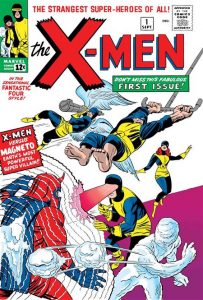 True Believers: X-Men #1 — Writer: Stan Lee; Pencils: Jack Kirby; Inks: Paul Reinman
True Believers: X-Men #1 — Writer: Stan Lee; Pencils: Jack Kirby; Inks: Paul Reinman
True Believers: Giant-Size X-Men #1 — Writer: Len Wein; Art: Dave Cockrum; Colors: Glynis Wein
X-Men Gold #1 — Writer: Marc Guggenheim; Pencils: Ardian Syaf; Inks: Jay Leisten; Colors: Frank Martin
In conjunction with this week’s release of X-Men Gold, the new “main” X-Men title, Marvel’s offering $1 reprints  of both 1963’s Lee/Kirby X-Men #1, and 1975’s Wein/Cockrum Giant-Size X-Men #1 (weird to consider that the distance between the Silver Age debut and the Bronze Age makeover was only twelve years — and that it’s been 42 years since then…). That’s not the only nostalgia; the new book’s first arc is titled “Back to the Basics,” an echo of John Byrne’s first issue of his long Fantastic Four run, and it reunites Storm, Nightcrawler, Colossus, Kitty Pryde, Wolverine (well, “a” Wolverine) and Prestige, who at
of both 1963’s Lee/Kirby X-Men #1, and 1975’s Wein/Cockrum Giant-Size X-Men #1 (weird to consider that the distance between the Silver Age debut and the Bronze Age makeover was only twelve years — and that it’s been 42 years since then…). That’s not the only nostalgia; the new book’s first arc is titled “Back to the Basics,” an echo of John Byrne’s first issue of his long Fantastic Four run, and it reunites Storm, Nightcrawler, Colossus, Kitty Pryde, Wolverine (well, “a” Wolverine) and Prestige, who at 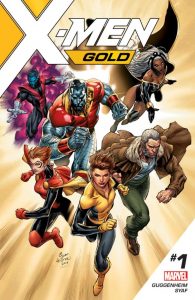 first looks like a new kid but who turns out to be an old friend; they demonstrate their powers by fighting a super-villain to protect a world that hates and fears them, and then play a game of baseball. Guggenheim writes an editorial that indicates he knows what he’s doing, and Syaf has a sturdy art style that can handle the dozens of characters and clear action that’s required — traits he shares with Giant-Size X-Men #1’s Dave Cockrum. As relaunches go, this is a hopeful one — and, if you don’t have them already, buying those two reprints for a total of $2, half the cost of one regular comic, is a no-brainer.
first looks like a new kid but who turns out to be an old friend; they demonstrate their powers by fighting a super-villain to protect a world that hates and fears them, and then play a game of baseball. Guggenheim writes an editorial that indicates he knows what he’s doing, and Syaf has a sturdy art style that can handle the dozens of characters and clear action that’s required — traits he shares with Giant-Size X-Men #1’s Dave Cockrum. As relaunches go, this is a hopeful one — and, if you don’t have them already, buying those two reprints for a total of $2, half the cost of one regular comic, is a no-brainer.
 Avengers #6 — Writer: Mark Waid; Art: Mike del Mundo; Colors: Mike del Mundo with Marco D’Alfonso
Avengers #6 — Writer: Mark Waid; Art: Mike del Mundo; Colors: Mike del Mundo with Marco D’Alfonso
Uncanny Avengers #22 — Writer: Gerry Duggan; Art: Pepe Larraz; Colors: David Curiel
Captain America: Steve Rogers #15 — Writer: Nick Spencer; Art: Javier Pina and Andres Guinaldo; Colors:  Rachelle Rosenberg
Rachelle Rosenberg
Of the Avengers-related books, the main title concludes its first relaunch tale, a battle with Kang the Conqueror that’s brought together the current team and, plucked from the timestream, the founders and an all-star  roster from both the past and future; it’s all been rendered in Mike del Mundo’s airy, painteresque and colorful style. Uncanny Avengers sees the end of a long battle with the Red Skull that resolves the brain-of-Professor-X thread that’s been dangling for years, and sends that bad guy over to Captain America for a final confrontation with Steve Rogers that opens the way to the looming Secret Empire spring/summer crossover event, making those books essential for meta-readers.
roster from both the past and future; it’s all been rendered in Mike del Mundo’s airy, painteresque and colorful style. Uncanny Avengers sees the end of a long battle with the Red Skull that resolves the brain-of-Professor-X thread that’s been dangling for years, and sends that bad guy over to Captain America for a final confrontation with Steve Rogers that opens the way to the looming Secret Empire spring/summer crossover event, making those books essential for meta-readers.
 Iron Fist #2 — Writer: Ed Brisson; Art: Mike Perkins; Colors: Andy Troy
Iron Fist #2 — Writer: Ed Brisson; Art: Mike Perkins; Colors: Andy Troy
Star Wars: Rogue One Adaptation #1 (of 6) — Writer: Jody Houser; Art: Emilio Laiso and Oscar Bazaldua
Jessica Jones #7 — Writer: Brian Michael Bendis; Art: Michael Gaydos; Colors: Matt Hollingsworth
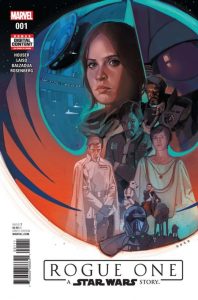 Of the current-media-stars books, Iron Fist continues its martial-arts-tournament story, with Danny having to fight seven masters to regain his confidence and chi and, you know, save the world or whatever; if they can keep this as brisk and entertaining as the first few issues, and don’t spin it out for too long, it’ll be a
Of the current-media-stars books, Iron Fist continues its martial-arts-tournament story, with Danny having to fight seven masters to regain his confidence and chi and, you know, save the world or whatever; if they can keep this as brisk and entertaining as the first few issues, and don’t spin it out for too long, it’ll be a 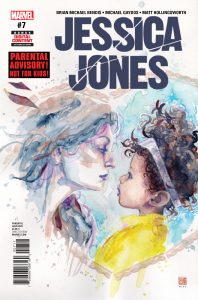 decent start. Star Wars launches an adaptation of the Rogue One movie that would have been a cool Christmas present three months ago, but should still appeal to younger fans, especially. Jessica Jones offers a coda to its first extended story, with a Luke/Jessica/baby reunion that’s exactly as touching and frustrating and unexpectedly funny and sad as this series gets at its best; the last page launches the next serial, but sometimes these stand-alone breather episodes are the ones everyone looks back on most fondly….
decent start. Star Wars launches an adaptation of the Rogue One movie that would have been a cool Christmas present three months ago, but should still appeal to younger fans, especially. Jessica Jones offers a coda to its first extended story, with a Luke/Jessica/baby reunion that’s exactly as touching and frustrating and unexpectedly funny and sad as this series gets at its best; the last page launches the next serial, but sometimes these stand-alone breather episodes are the ones everyone looks back on most fondly….
 Spider-Man #15 — Writer: Brian Michael Bendis; Art: Szymon Kudranski; Colors: Justin Ponsor
Spider-Man #15 — Writer: Brian Michael Bendis; Art: Szymon Kudranski; Colors: Justin Ponsor
Champions #7 — Writer: Mark Waid; Pencils: Humberto Ramos; Inks: Victor Olazaba; Colors: Edgar Delgado
Hawkeye #5 — Writer: Kelly Thompson; Art: Michael Walsh; Colors: Jordie Bellaire
America #2 — Writer: Gabby Rivera; Pencils: Joe 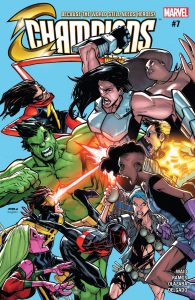 Quinones with Ming Doyle; Inks: Joe Rivera and Ming Doyle; Colors: Jose Villarrubia
Quinones with Ming Doyle; Inks: Joe Rivera and Ming Doyle; Colors: Jose Villarrubia
In the teen hero/YA category, the Miles Morales Spider-Man book offers its own breather issue, as the aftermath to its crossover with Spider-Gwen involves Miles’s mom finding out the truth of both his and his father’s double  lives, with predictably dramatic results. Champions sees the team fighting its dopplegangers, a Trumpian group of mercenary alt-righters who take on jobs like evicting low-income renters from inner-city tenements so the one-percenters can make a profit (no, really… and it’s surprisingly passionate and affecting, no small thanks to the Ramos art). Hawkeye starts a new story by guest-starring Jessica Jones, out in LA to show Kate the PI ropes, and somehow they end up fighting a dragon; Kelly
lives, with predictably dramatic results. Champions sees the team fighting its dopplegangers, a Trumpian group of mercenary alt-righters who take on jobs like evicting low-income renters from inner-city tenements so the one-percenters can make a profit (no, really… and it’s surprisingly passionate and affecting, no small thanks to the Ramos art). Hawkeye starts a new story by guest-starring Jessica Jones, out in LA to show Kate the PI ropes, and somehow they end up fighting a dragon; Kelly  Thompson has, quietly, become one of the best writers in the business, with appealing characterization and subtle, universal themes, and Michael Walsh manages to echo David Aja’s ground-breaking work on the earlier Fraction version of this book and still add enough personality to make it his own. America, on the other hand, hasn’t quite found its footing; it knows its title heroine is a college-age Latina lesbian with super-strength and dimension-travelling abilities, but that’s more a collection of attributes than a person. It’s just the second issue, though, and there are enough encouraging signs to give the book’s creative team a couple more months to find her voice.
Thompson has, quietly, become one of the best writers in the business, with appealing characterization and subtle, universal themes, and Michael Walsh manages to echo David Aja’s ground-breaking work on the earlier Fraction version of this book and still add enough personality to make it his own. America, on the other hand, hasn’t quite found its footing; it knows its title heroine is a college-age Latina lesbian with super-strength and dimension-travelling abilities, but that’s more a collection of attributes than a person. It’s just the second issue, though, and there are enough encouraging signs to give the book’s creative team a couple more months to find her voice.
 Superman #20 — Writer: Patrick Gleason and Peter J. Tomasi; Pencils: Patrick Gleason; Inks: Mick Gray; Colors: John Kalisz
Superman #20 — Writer: Patrick Gleason and Peter J. Tomasi; Pencils: Patrick Gleason; Inks: Mick Gray; Colors: John Kalisz
Batman #20 — Writer: Tom King; Pencils: David Finch; Inks: Danny Miki and Trevor Scott; Colors: Jordie Bellaire
Harley Quinn #17 — Writers: Amanda Conner and Jimmy Palmiotti; Art: John Timms; Inks: John Timms with Marc Deering; Colors: Alex Sinclair (Second story): Writers: Paul Dini and Jimmy Palmiotti; Pencils: Bret Blevins; Inks: Jay Bone; Colors: Alex Sinclair
Only a couple of DC books this week, but it’s noteworthy that their two biggest characters continue to carry much of the weight of the company’s current success — the Superman titles have just come off a crossover that did nothing less than  reintegrate the entire DC timeline, and here they’re beginning a new arc guest-starring Batman and Damian, as both the super-dads and super-sons investigate some quirks in Superboy’s powers, which (of course) turn out to have sinister causes. With plots that feel like they’re important to the larger DC world, and the clear, attractive art from Patrick Gleason, Superman has been a comic worth reading for quite a while. Even more so for Batman (which has been worth reading ever since Scott Snyder took it over before the new-52 era), where writer Tom King has managed to keep the book at the top of the sales charts with a combination of new characters, fan-friendly stories (Batman and Catwoman having a rooftop hookup) and popular villains — witness the current issue, which concludes a five-parter culminating in a heavyweight fight with Bane: twenty pages of brutal battle by David Finch, who was born to draw stuff like this. Add in King’s canny psychological insights, and you get punching and characterization: the recipe for a
reintegrate the entire DC timeline, and here they’re beginning a new arc guest-starring Batman and Damian, as both the super-dads and super-sons investigate some quirks in Superboy’s powers, which (of course) turn out to have sinister causes. With plots that feel like they’re important to the larger DC world, and the clear, attractive art from Patrick Gleason, Superman has been a comic worth reading for quite a while. Even more so for Batman (which has been worth reading ever since Scott Snyder took it over before the new-52 era), where writer Tom King has managed to keep the book at the top of the sales charts with a combination of new characters, fan-friendly stories (Batman and Catwoman having a rooftop hookup) and popular villains — witness the current issue, which concludes a five-parter culminating in a heavyweight fight with Bane: twenty pages of brutal battle by David Finch, who was born to draw stuff like this. Add in King’s canny psychological insights, and you get punching and characterization: the recipe for a 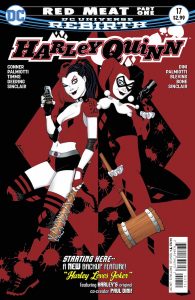 decent superhero comic. Harley Quinn’s worth noting not so much for its main story (the first part of a tale involving homeless people disappearing from the streets, and Harley and crew being tapped by the mayor to investigate), but for the backup, which begins a three-parter written by Harley co-creator Paul Dini, and set in the Batman cartoon universe, where she and the Joker are still an item; no Bruce Timm art, but Bret Blevins, who drew a lot of those wonderful Batman Adventure TV tie-ins, offers a close, classy imitation, and this sequel to Mad Love, even at only six pages, is reason enough to buy the book.
decent superhero comic. Harley Quinn’s worth noting not so much for its main story (the first part of a tale involving homeless people disappearing from the streets, and Harley and crew being tapped by the mayor to investigate), but for the backup, which begins a three-parter written by Harley co-creator Paul Dini, and set in the Batman cartoon universe, where she and the Joker are still an item; no Bruce Timm art, but Bret Blevins, who drew a lot of those wonderful Batman Adventure TV tie-ins, offers a close, classy imitation, and this sequel to Mad Love, even at only six pages, is reason enough to buy the book.
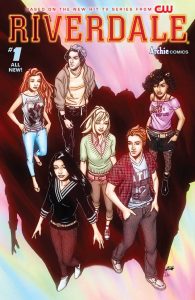 Riverdale #1 — Writer: Will Ewing; Art: Joe Eisma; Colors: Andre Szymanowicz
Riverdale #1 — Writer: Will Ewing; Art: Joe Eisma; Colors: Andre Szymanowicz
Jughead #14 — Writer: Ryan North; Art/Colors: Derek Charm
Little Archie and His Pals #1 (of 1) — Writers: Art Baltazar and Franco; Art: Art Baltazar
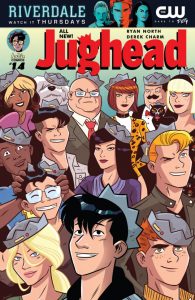 Revolution: Ah Yeah #1 — Creator Art Baltazar
Revolution: Ah Yeah #1 — Creator Art Baltazar
Archie comics are certainly back on the comic-fan radar, between the company’s modernization of its books and the Riverdale TV series; Riverdale #1, of course, is based on that show, and if you like its mashup of the Archieverse, Twin Peaks and The OC, then you’ll like this comic; fans of the regular Archie 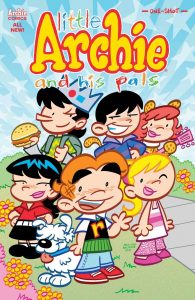 books, however, will probably be put off by the emphasis on soapy teen drama instead of humor. Those fans should be checking out Jughead instead, where Ryan North knows exactly how to combine slapstick comedy with modern social-media themes, and the Derek Charm art makes it look cool, cartoony and fun: this is the poster child for the new Archie books, a good argument for why everyone should be reading them. For even-younger
books, however, will probably be put off by the emphasis on soapy teen drama instead of humor. Those fans should be checking out Jughead instead, where Ryan North knows exactly how to combine slapstick comedy with modern social-media themes, and the Derek Charm art makes it look cool, cartoony and fun: this is the poster child for the new Archie books, a good argument for why everyone should be reading them. For even-younger 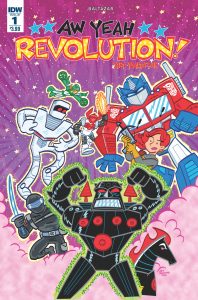 readers, there’s Little Archie, where the Baltazar/Franco team (Tiny Titans; Super Powers) lends its combination of super-cute, faux-primitive art, humor and continuity-consistent characterization to the Riverdale gang. If you like that, check out Baltazar’s solo Revolution: Aw Yeah one-shot for IDW, where he applies that same colorful, oddly-appealing style to Rom, the Transformers and G.I. Joe. This stuff, with its crayon aesthetic, is a magnet for pre- and beginning readers, so if you have anyone like that on your shopping list, pick these up: it’s never too early to get kids hooked on comics….
readers, there’s Little Archie, where the Baltazar/Franco team (Tiny Titans; Super Powers) lends its combination of super-cute, faux-primitive art, humor and continuity-consistent characterization to the Riverdale gang. If you like that, check out Baltazar’s solo Revolution: Aw Yeah one-shot for IDW, where he applies that same colorful, oddly-appealing style to Rom, the Transformers and G.I. Joe. This stuff, with its crayon aesthetic, is a magnet for pre- and beginning readers, so if you have anyone like that on your shopping list, pick these up: it’s never too early to get kids hooked on comics….
 Kim Reaper #1 — Creator: Sarah Graley
Kim Reaper #1 — Creator: Sarah Graley
Eleanor and the Egret #1 — Writer: John Layman; Art: Sam Kieth; Colors: Ronda Pattison
Black Cloud #1 — Story: Jason Latour and Ivan Brandon; Script: Ivan Brandon; Art: Greg Hinkle; Colors: Matt Wilson
The Sovereigns #0 — Writer: Ray Fawkes; Art: Johnny Desjardins; Colors: Mohan
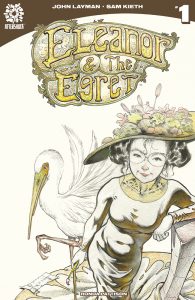 Rock Candy Mountain #1 — Writer/Artist: Kyle Starks; Colors: Chris Schweizer
Rock Candy Mountain #1 — Writer/Artist: Kyle Starks; Colors: Chris Schweizer
As usual, lots of indy debuts this week: Kim Reaper is for the Jonesy/Backstagers/Lumberjanes crowd, and is about a college freshman who’s also a part-time Grim Reaper — but only for animals — and has another freshman with a crush on her accidentally follow her to her next job, after which, naturally, hijinx result. Pretty good, at least so far, with an absurdist sense of humor and some decent dialogue; if you like any of those books I just mentioned, this one is worth a look, too.  Eleanor and the Egret is the newest offering from Sam Kieth, with his usual combination of surreal situations (the egret talks) and beautifully-drawn women. Kieth’s own writing sometimes wanders, so another attraction here is the writer, John Layman, fresh off the conclusion of Chew; he demonstrated a knack for combining comedy and drama with imaginative plotting in that series, leading to high hopes for this one. Black Cloud is a new Image fantasy title about a girl who can toggle between our dimension and a magic-filled, anthropomorphic one; she’s running a scam where she gives college kids Flintstones vitamins, takes one to the magic dimension,
Eleanor and the Egret is the newest offering from Sam Kieth, with his usual combination of surreal situations (the egret talks) and beautifully-drawn women. Kieth’s own writing sometimes wanders, so another attraction here is the writer, John Layman, fresh off the conclusion of Chew; he demonstrated a knack for combining comedy and drama with imaginative plotting in that series, leading to high hopes for this one. Black Cloud is a new Image fantasy title about a girl who can toggle between our dimension and a magic-filled, anthropomorphic one; she’s running a scam where she gives college kids Flintstones vitamins, takes one to the magic dimension, 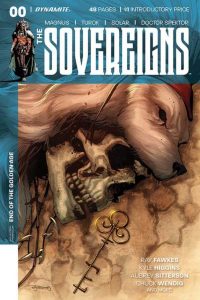 pretends it was the pills that did it, and then sells the pills for big bucks. Greg Hinkle’s art is good at both the more exotic locales (there’s a bar that looks like a more urbane and mob-influenced version of the Star Wars cantina) and the earth-side street scenes, and there’s clearly a big, well-imagined backstory here. Unfortunately, the Bleeding Cool website did a push piece on the comic this week that touted it as an investment, so at this point it’s probably sold out — but there’s a second print coming, and it’s worth it to get in one the ground floor of a new story like this and see where it leads. The Sovereigns is Dynamite’s newest attempt to make money from the old Gold Key superhero characters — Turok, Magnus and Doctor Spektor, so far, with Solar still to
pretends it was the pills that did it, and then sells the pills for big bucks. Greg Hinkle’s art is good at both the more exotic locales (there’s a bar that looks like a more urbane and mob-influenced version of the Star Wars cantina) and the earth-side street scenes, and there’s clearly a big, well-imagined backstory here. Unfortunately, the Bleeding Cool website did a push piece on the comic this week that touted it as an investment, so at this point it’s probably sold out — but there’s a second print coming, and it’s worth it to get in one the ground floor of a new story like this and see where it leads. The Sovereigns is Dynamite’s newest attempt to make money from the old Gold Key superhero characters — Turok, Magnus and Doctor Spektor, so far, with Solar still to 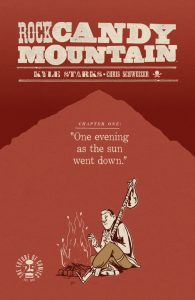 come — by teaming up rebooted versions of them to fight the usual time-tossed crisis; if you have fond memories of those heroes from the ’60s, or the ’90s Valiant versions, then this is worth a look. Rock Candy Mountain is about a freight-hopping hobo in the late 1940s who’s more than he seems, and takes a rookie rail-rider under his wings; it’s another fantasy book from Image, and gets points for Kyle Starks’s fluid, minimalist style and for his two-page editorial explaining the origins of the often-covered folk song “Big Rock Candy Mountain” as a hobo version of paradise: well-researched, and an interesting angle on the comic’s origins and ultimate themes.
come — by teaming up rebooted versions of them to fight the usual time-tossed crisis; if you have fond memories of those heroes from the ’60s, or the ’90s Valiant versions, then this is worth a look. Rock Candy Mountain is about a freight-hopping hobo in the late 1940s who’s more than he seems, and takes a rookie rail-rider under his wings; it’s another fantasy book from Image, and gets points for Kyle Starks’s fluid, minimalist style and for his two-page editorial explaining the origins of the often-covered folk song “Big Rock Candy Mountain” as a hobo version of paradise: well-researched, and an interesting angle on the comic’s origins and ultimate themes.
 Sun Bakery #2 — Creator: Corey Lewis
Sun Bakery #2 — Creator: Corey Lewis
Animal Noir #3 (of 4) — Writers: Izar Lunacek and Nejc Juren; Art/Colors: Izar Lunacek
Motor Girl #5 — Creator: Terry Moore
Paper Girls #13 — Writer: Brian K. Vaughan; Art: Cliff Chiang; Colors: Matt Wilson
Providence #12 (of 12) — Writer: Alan Moore; Art: Jacen Burrows; Colors: Juan Rodriguez
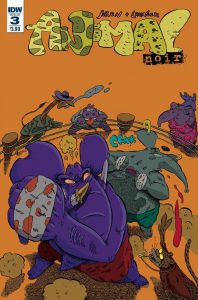 Sun Bakery is the second issue of Corey Lewis’s entirely self-generated anthology series, with a number of serial stories in different styles: Arem Lightstorm is space opera, a mashup of Japanese and European influences that wouldn’t be out of place in Heavy Metal; Dream Skills inhabits Bryan Lee O’Malley/Scott Pilgrim territory; Bat Rider is in a spare, black-and-white, almost woodcut style that reminds me of Jim Mahfood; and Dead Naked is a western told almost entirely in silhouette. All of this gets filtered through Lewis’s own manga sensibilities, and the result is 47 pages of
Sun Bakery is the second issue of Corey Lewis’s entirely self-generated anthology series, with a number of serial stories in different styles: Arem Lightstorm is space opera, a mashup of Japanese and European influences that wouldn’t be out of place in Heavy Metal; Dream Skills inhabits Bryan Lee O’Malley/Scott Pilgrim territory; Bat Rider is in a spare, black-and-white, almost woodcut style that reminds me of Jim Mahfood; and Dead Naked is a western told almost entirely in silhouette. All of this gets filtered through Lewis’s own manga sensibilities, and the result is 47 pages of  comics that never get dull or boring, and offer more than enough entertainment for your $4.99. Animal Noir continues its Raymond-Chandler-crossed-with-Zootopia mini-series; it’s got a loose, freewheeling style and a combination of bigfoot drawing and noir that’s hard to define — slapstick drama? — but fun to read. Motor Girl has something of the same combo — but more weighted toward the drama — although Terry Moore, after Strangers in Paradise, Echo and Rachel Rising, is a much more known quantity; this series about a woman who’s a war vet
comics that never get dull or boring, and offer more than enough entertainment for your $4.99. Animal Noir continues its Raymond-Chandler-crossed-with-Zootopia mini-series; it’s got a loose, freewheeling style and a combination of bigfoot drawing and noir that’s hard to define — slapstick drama? — but fun to read. Motor Girl has something of the same combo — but more weighted toward the drama — although Terry Moore, after Strangers in Paradise, Echo and Rachel Rising, is a much more known quantity; this series about a woman who’s a war vet  with PTSD, an imaginary talking gorilla as a confidante, and UFO aliens who may or may not be benign hanging around the desert junkyard where she’s a mechanic is as smart and thoughtful and sympathetic to its characters (and well-drawn) as all his others. Paper Girls has settled into a Saturday-morning-serial groove, every issue advancing the story and featuring one, and sometimes two, splashy climaxes or reveals or unexpected plot twists; Vaughan’s other title, Saga, does the same thing, and it’s an effective way to addict readers, and keep them coming back
with PTSD, an imaginary talking gorilla as a confidante, and UFO aliens who may or may not be benign hanging around the desert junkyard where she’s a mechanic is as smart and thoughtful and sympathetic to its characters (and well-drawn) as all his others. Paper Girls has settled into a Saturday-morning-serial groove, every issue advancing the story and featuring one, and sometimes two, splashy climaxes or reveals or unexpected plot twists; Vaughan’s other title, Saga, does the same thing, and it’s an effective way to addict readers, and keep them coming back 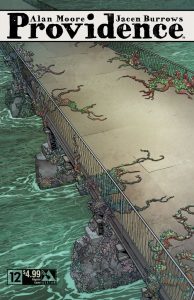 month after month. Providence is a good way to end this list: it’s about the end of days and the arrival of the elder gods, and the culmination of over twenty years of Lovecraftian fiction by Moore, starting with “The Courtyard,” and running through Neonomicon to Providence itself. Many familiar faces from those earlier books show up here, and there are enough Easter eggs (er… Cthulhu eggs?) to keep HPL annotators busy for months. Moore’s said that this is the last comic he’s planning to write, and it ends on a typically unsettled note: the universe changed for the darker, with uneasy survivors facing an uncertain future — not the most optimistic farewell, but a memorable one.
month after month. Providence is a good way to end this list: it’s about the end of days and the arrival of the elder gods, and the culmination of over twenty years of Lovecraftian fiction by Moore, starting with “The Courtyard,” and running through Neonomicon to Providence itself. Many familiar faces from those earlier books show up here, and there are enough Easter eggs (er… Cthulhu eggs?) to keep HPL annotators busy for months. Moore’s said that this is the last comic he’s planning to write, and it ends on a typically unsettled note: the universe changed for the darker, with uneasy survivors facing an uncertain future — not the most optimistic farewell, but a memorable one.



